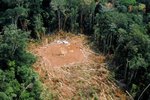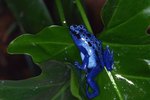
Poison dart frogs comprise two families of frog species, Dendrobatidae and Aromobatidae, native to rainforests of South and Central America. About a quarter of the more than 200 species are listed as threatened or critically endangered. Ranging from barely 1 inch to 2 1/2 inches in length, these day-active frogs display bright colors that help predators remember they are inedible. Although in the wild their poison is deadly, poison dart frogs born in captivity are not poisonous. Scientists believe the wild-born frogs acquire and store toxins from insects they eat, which collect the toxins from rainforest plants. Several man-made hazards impact these frogs.
Loss of Habitat

Perhaps the primary threat to poison dart frogs is the logging and clearing of the rainforests where they live. Deforestation directly destroys their habitat, and leaves a hotter, drier terrain that provides no place or food for them. Clearing large swaths of rainforest while leaving islands of poison dart frog habitat can also isolate and trap populations in very restricted areas, leaving them greatly endangered.
Pollution
Various chemicals commonly used in local farming retard the growth of poison dart frogs, and disrupt their reproductive cycles. Pesticides kill insects, leaving the frogs without a food supply, while fertilizers contaminate bodies of water. These pollutants also are carried aloft in the atmosphere and distributed in mist and fog, contaminating regions far removed from the farming itself. Acid rain can kill larvae or inhibit their development, while pollutants in general weaken the frogs’ immune systems and make them more susceptible to infection and disease.
Infectious Disease
Poison dart frogs, like other amphibian species around the world, have been plagued by a fungal disease called chytridiomycosis. The Centers for Disease Control and Prevention reports that researchers believe spread of this fungus was caused by the international transport of amphibians, and that it originated in southern Africa around 1938. Herpetologists blame this fungus for the greatest disease-caused loss of biodiversity, both plant and animal, in recorded history. Globally, the fungus has caused the decline or extinction of at least 200 frog species alone.
Smuggling

European and American collectors prize the brightly colored poison dart frogs, resulting in a high demand in the international pet trade for new and increasingly rare specimens. Wild poison dart frogs are protected by treaty, but that increases their value to smugglers, who export them illegally to capitalize on the demand. Smugglers hide these little frogs in luggage, or concealed in legal shipments of exported tropical fish. Customs officials estimate close to 90 percent of illegally exported poison dart frogs die in transport because of the poor shipping conditions.
References
- Dendrobates.org: About Poison Frogs
- Dendrobates.org: Smuggling
- Amphibiaweb.org: Chytridiomycosis
- Tropical Rainforest Animals: Causes of Amphibian Declines, Still not Totally Clear
- Smithsonian National Zoological Park: Poison Dart Frog Fact Sheet
- JRank Articles: Poison Frogs: Dendrobatidae Conservation Status
- Be Green: Where Did the Frogs Go?
- CDC: Origins of the Amphibian Chytrid Fungus
Photo Credits
-
Jupiterimages/Photos.com/Getty Images
Writer Bio
Jennifer Mueller began writing and editing professionally in 1995, when she became sports editor of her university's newspaper while also writing a bi-monthly general interest column for an independent tourist publication. Mueller holds a Bachelor of Arts in political science from the University of North Carolina at Asheville and a Juris Doctor from Indiana University Maurer School of Law.




